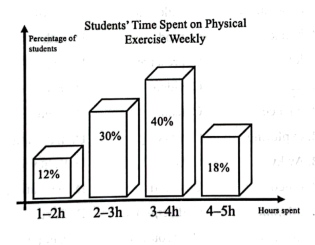1. 描述调查结果;
2. 分析其原因并给出建议。

1. 写作词数应为80左右;
2. 短文的题目和首句已为你写好。
Students’ Time Spent on Physical Exercise Weekly
Nowadays, many students are aware of the significance of physical exercise, although the time they spend on it varies.
_______________________________________________________________________________________________________________________________________________________________________________________________________________________________________________________________________________________________________________________________________________________________________________________________________________________________________________________________________2 . You see a shopper trip over in a busy street. Someone else can help. That’s what you tell yourself. This is the bystander effect in action — the dilution (淡化) of responsibility in the presence of others — and it has been demonstrated in many past studies.
But life is complicated and psychologists have seen exceptional circumstances. Two experiments were conducted by Marco van Bommel and his team using an online chat room for people with extreme emotional problems. Eighty-six students were logged into the forum (论坛) and shown five messages from troubled users. They were told to write a reply if they wanted, but it was entirely up to them.
Basically, participants could see their names on the screen alongside others’ names. A counter also told them if the forum was quiet, with just one other person logged in, or busy, with 30 others online. This arrangement reproduced the classic Bystander Effect-participants were less likely to post replies with more people logged in. However, when the researchers cued (提示) self-awareness by highlighting participants’ names in red on the screen, they posted more replies on a busy forum.
A second study was built on these findings, but this time self-awareness was raised by the presence, or not, of a computer web-camera. Over 100 participants took part. Although told the camera wouldn’t be used until later, those with cameras were asked to check the camera’s indicator-light during the study. The Bystander Effect was reproduced when web-cameras were absent-on busy forums participants posted fewer replies to needy users. By contrast, those cued to be self-aware by the web-cam actually wrote more replies.
Nearly any online community can benefit from the research. The ability to turn hesitant bystanders into eager helpers is a recipe for engagement and collective benefit. As in the research, simple design cues could be integrated to help online users remember they are visible to the community. For example, the size of profile images and specific on-site reminders can be used to highlight how users see themselves within the community.
1. What does the underlined word “it” in paragraph 1 refer to?| A.The hidden danger of a busy street. |
| B.The bystander effect in action. |
| C.The dilution of responsibility. |
| D.The presence of other people. |
| A.there were more emotional problems |
| B.the counter indicated the forum was quiet |
| C.their presence was reminded on the screen |
| D.more individuals were logged in the forum |
| A.To encourage more replies. |
| B.To reproduce the bystander effect. |
| C.To further test participants’ mindset. |
| D.To better record participants’ actions. |
| A.Working together to attract more users. |
| B.Combining designs to boost users’ memory. |
| C.Building more platforms for public promotion. |
| D.Exploring ways to change bystanders into upstanders. |
3 . Decision hard
From the moment we wake up each day, we’re faced with a continuous stream of choices.
When decision fatigue kicks in, you may feel like you just don’t have the mental bandwidth to deal with more decisions.
Here’s how to minimize or manage this phenomenon:
Tune into how you’re feeling. Be watchful of signs of decision fatigue and act accordingly: If you’ve had a demanding day that was filled with lots of decisions, put off making another one if you can. If things that wouldn’t normally upset you start bothering you, consider that a sign that you may not be in the best state of mind to make a major decision. “People may not realize that they’re experiencing decision fatigue,” Baumeister, a professor of psychology at the University of Queensland in Australia, says. “
| A.Make some choices automatic |
| B.It’s something to watch out for |
| C.They should turn to the experts for advice |
| D.Put down what you have in hand and take a break from them |
| E.This can lead to decisional disfunction or decreased self-control |
| F.If you like having oatmeal for breakfast, stick with it on a daily basis |
| G.We tend to feel overwhelmed, anxious, stressed or otherwise out of sorts |



